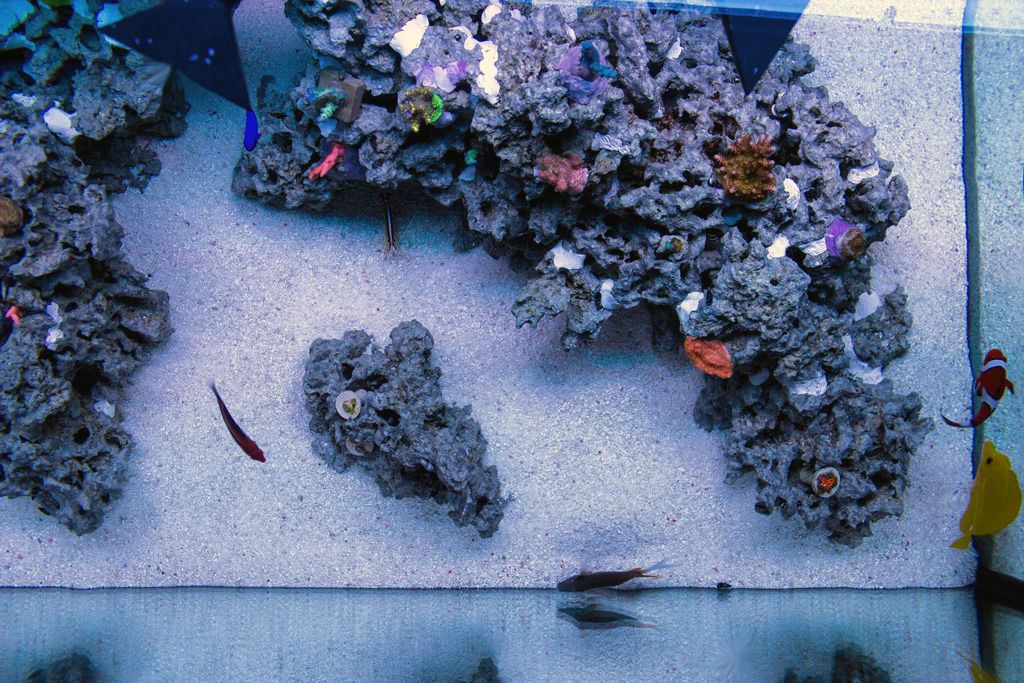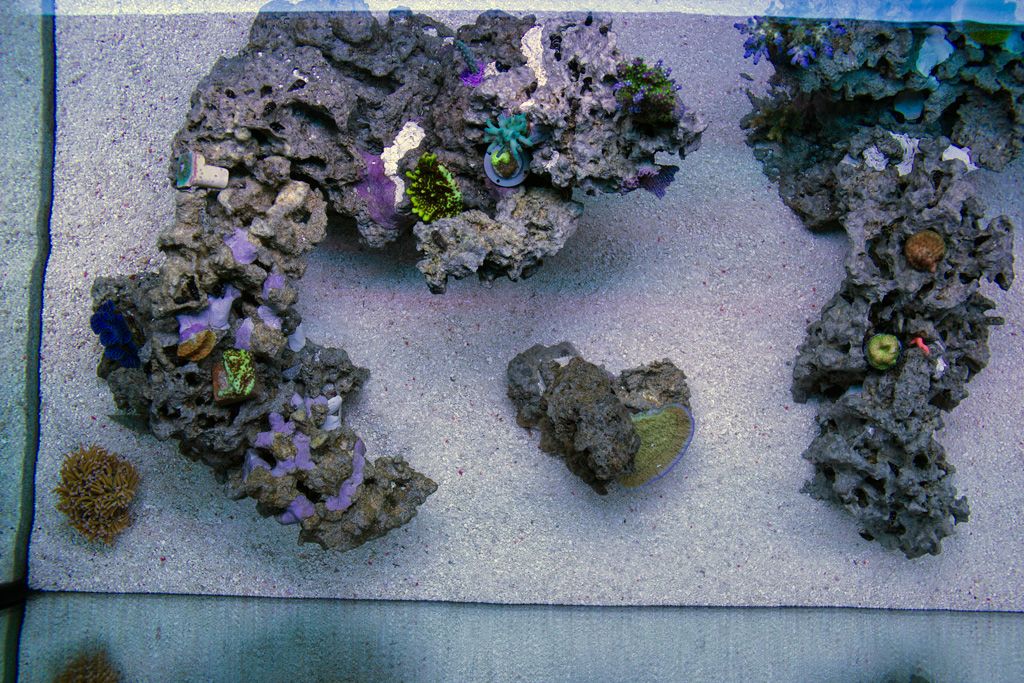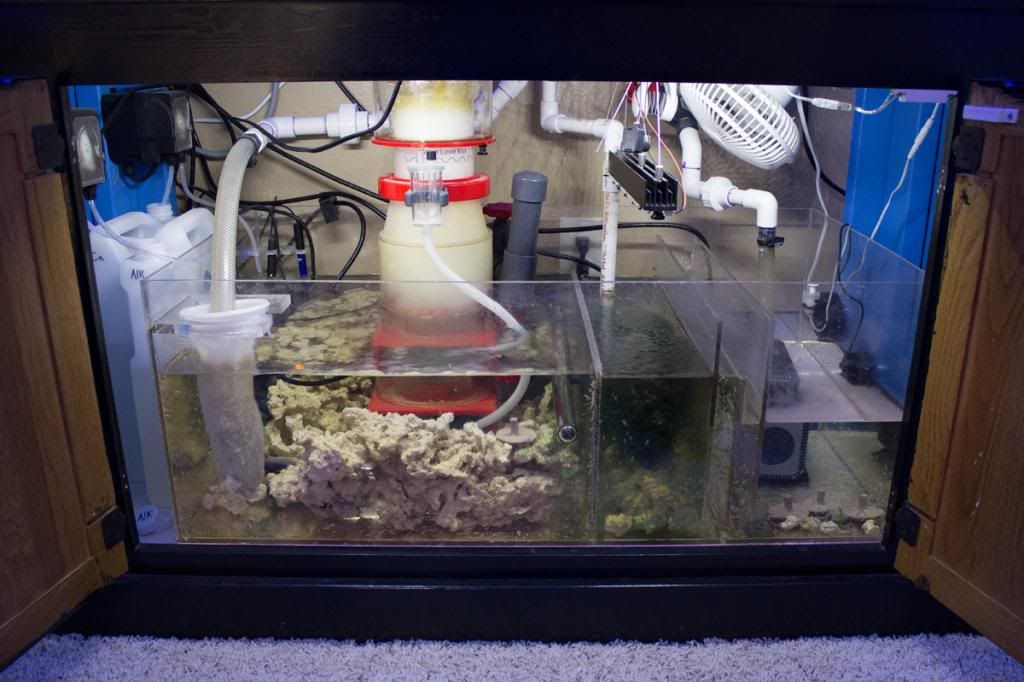


|
 |
|
|
#51 | |
|
They call me EC
Join Date: Apr 2007
Location: central Florida
Posts: 6,208
|
Quote:
__________________
"Most of the failures with marine aquaria are due to lack of knowledge of the biological processes that occur in the aquarium." Martin A. Moe, Jr. "A scientist seeks the truth, wherever that may lead. A believer already knows the truth, and cannot be swayed no matter how compelling the evidence." Current Tank Info: I'm trying to see how many tanks will fit in my house before the wife loses it. |
|
|
|

|
|
|
#52 |
|
Registered Member
Join Date: Jan 2005
Location: Lynchburg, Va
Posts: 2,963
|
great read going to tag along
|
|
|

|
|
|
#53 |
|
Registered Member
Join Date: Dec 2012
Posts: 6
|
I'm interested in some feedback on feeding frequency and amount as well. I typically just feed once per day, switching between flakes and mysis, with nori for my tang every few days. I assume this is low, but what are the recommended amounts for sps dominated tanks? I have a skimmer rated for 3x the size of my tank so I'm not worried about getting the waste out.
|
|
|

|
|
|
#54 | |
|
Registered Member
Join Date: May 2008
Location: Lehigh Valley, Pennsylvania
Posts: 266
|
Quote:
__________________
150 Gallon Oceanic SPS Reef Tank 40 Gallon Sump Current Tank Info: 150 RR Oceanic |
|
|
|

|
|
|
#55 | |
|
Registered Member
Join Date: May 2008
Location: Lehigh Valley, Pennsylvania
Posts: 266
|
Quote:
__________________
150 Gallon Oceanic SPS Reef Tank 40 Gallon Sump Current Tank Info: 150 RR Oceanic |
|
|
|

|
|
|
#56 | |
|
Registered Member
Join Date: Feb 2007
Location: Santa Monica, California, USA
Posts: 2,511
|
Quote:
__________________
Inventor of the easy-to-DIY upflow scrubber, and also the waterfall scrubber that everyone loves to build: http://www.reefcentral.com/forums/showthread.php?t=1424843 |
|
|
|

|
|
|
#57 |
|
Registered Member
Join Date: Apr 2003
Location: Durham, NC
Posts: 739
|
it is important to note that removing detritus is removing the source of the inorganic phosphates. skipping an entire step. no need for GFO if the detritus is removed.
inorganic phosphates is a waste product of the decomposition of food and animal wastes. remove these then the need for inorganic phosphate binders is significantly reduced. to me it just makes more sense to go after the source instead of the product, when the source is not something we want in the system either. G~
__________________
Friends don't let friends use refugiums. Current Tank Info: Not dead yet. |
|
|

|
|
|
#58 |
|
Registered Member
Join Date: Mar 2009
Location: East Bay, Northern California
Posts: 658
|
^^
Correct. Regular detritus removal is a very effective method of controlling phosphate. GFO can be used, of course, but typically shouldn't be needed in a balanced system with regular detritus removal/WCs. |
|
|

|
|
|
#59 | |
|
Registered Member
Join Date: Mar 2009
Location: East Bay, Northern California
Posts: 658
|
Quote:
Removal of waste products is crucial, especially as feeding increases. Regular detritus removal ('vacuuming') will go a long way to removing the source of nutrients, such as phosphate, that degrade the system. |
|
|
|

|
|
|
#60 |
|
Registered Member
Join Date: Oct 2002
Location: South Euclid, OH
Posts: 4,281
|
If you truely have control over your system..........you should be able to adjust your nutrient export system & not have to add more food, fish, ect. It's fine to do that if your tank is void of fish or lightly stocked. In most other cases you should be able to tweek things and fine tune it.
Too many people have way too much complexity and 3-4 different types of phosphate/nitrate control tools are used. There is no need for that.
__________________
80g Rimless Acropora System reefcentral.com/forums/showthread.php?t=2197142&page=31 Ed |
|
|

|
|
|
#61 | |
|
Registered Member
Join Date: Feb 2007
Location: Santa Monica, California, USA
Posts: 2,511
|
Quote:

__________________
Inventor of the easy-to-DIY upflow scrubber, and also the waterfall scrubber that everyone loves to build: http://www.reefcentral.com/forums/showthread.php?t=1424843 |
|
|
|

|
|
|
#62 |
|
Registered Member
Join Date: Mar 2009
Location: East Bay, Northern California
Posts: 658
|
If one is already adding too much food, then yes, correct.
However, a minimum amount of organic phosphate and other nutrients must be regularly available to the corals and other organisms to sustain life processes, preferably a bit more for growth. Otherwise corals will slowly starve as their energy reserves are depleted. Regular removal of substances that reduce to or contain 'waste products' (such as inorganic phosphate, nitrates, etc.) is what we need, so detritus should be regularly exported from the system. |
|
|

|
|
|
#63 | |
|
Registered Member
Join Date: Jan 2005
Location: Lynchburg, Va
Posts: 2,963
|
Quote:
|
|
|
|

|
|
|
#64 | |
|
Registered Member
Join Date: Mar 2009
Location: East Bay, Northern California
Posts: 658
|
Quote:
I would bet good money that you can eliminate your use of GFO by simply increasing your detritus removal. |
|
|
|

|
|
|
#65 | |
|
Registered Member
Join Date: Jan 2005
Location: Lynchburg, Va
Posts: 2,963
|
Quote:
|
|
|
|

|
|
|
#66 |
|
Registered Member
Join Date: May 2010
Location: Decatur, IL
Posts: 1,048
|
^^
I'm don't really know what I'm talking about... Lol, but isn't that what was stated earlier? The PO4 you can test for isn't the 'food' your coral needs, it's the organically bound phosphates you want for your SPS, and the water soluable inorganic phosphates that you are testing. So someone please correct me if I have this wrong, but wouldnt he want to crank back up the skimmer and feed more? I'm only posting to see if I am starting to understand. |
|
|

|
|
|
#67 | |
|
Registered Member
Join Date: Mar 2009
Location: East Bay, Northern California
Posts: 658
|
Quote:
The best way that I have found to go about this is to use bio markers, namely the corals and algae. If the SPS corals are pale, SLOWLY increase feeding until colors improve to your liking and keep the input level there. If nuisance algae don't get out of hand, then detritus removal/skimming (and some use GFO) is sufficient to handle the food inputs. However, if algae/cyano start to flourish, do not reduce feeding, but concentrate on more efficient waste export via increased detritus removal/skimming heavy/WCs (singly or in combination...whatever works) and regularly remove the nuisance algae until the algae growth is back to levels manageable by the tank's herbivores. Last edited by Nano sapiens; 02/13/2013 at 12:03 AM. |
|
|
|

|
|
|
#68 | |
|
They call me EC
Join Date: Apr 2007
Location: central Florida
Posts: 6,208
|
Quote:
Here's a simple test to know if you're feeding your tangs enough. Go to Youtube and search for surgeonfish or tangs in the wild. View multiple videos. Note how smooth and rounded their sides are, with no signs of a back bone. When you come to a head on shot, pause the video then compare the girth of the fish to your fish. If your fish aren't as thick and meaty as the ones in the wild, you're likely not feeding enough. The tangs in the wild graze pretty much all day long. Unfortunately, most of us form an opinion of what a healthy tang should look like by viewing them at our LFS. Most of these fish are way under weight. They may not have eaten since the day they were collected. IMHO, this is why tangs are so prone to ailments associated with nutritional deficiencies like HALLE, and even Ich. The good thing is that if you feed those fish adequately, you should have no problem supplying adequate nutrition to most corals. The bad part is that you will really need to stay on top of maintenance, and you'll need a very good filtration system.
__________________
"Most of the failures with marine aquaria are due to lack of knowledge of the biological processes that occur in the aquarium." Martin A. Moe, Jr. "A scientist seeks the truth, wherever that may lead. A believer already knows the truth, and cannot be swayed no matter how compelling the evidence." Current Tank Info: I'm trying to see how many tanks will fit in my house before the wife loses it. |
|
|
|

|
|
|
#69 | |
|
Registered Member
Join Date: May 2008
Location: Lehigh Valley, Pennsylvania
Posts: 266
|
Quote:
__________________
150 Gallon Oceanic SPS Reef Tank 40 Gallon Sump Current Tank Info: 150 RR Oceanic |
|
|
|

|
|
|
#70 | |
|
They call me EC
Join Date: Apr 2007
Location: central Florida
Posts: 6,208
|
Quote:
 I have been fallowing your thread, and your corals are not starving. JPMagyar aka Joe, and myself have tried to explain what the problem is. You contacted a salesman from a popular supplement/food company and he told you what we would expect him to say. {Dump more of my product in your tank.} You are feeding your corals far more than most of us and yet you have been told that your corals are starving. They are not. In this thread, Nano sapiens has explained the importance of "bio markers". In your system the "bio markers" are screaming at you. Algae is growing, Xenia is loving life, your stony corals are suffering or dying, and you have 4" of rotting organic matter on the bottom of the tank. Reefin Dude, Nano sapiens, and myself have tried to explain the importance of removing this rotting organic matter from our systems. Your system is a prime example of what happens when you fail to remove this material. Those organisms that flourish in higher nutrient environments, like algae and Xenia prosper, those that flourish in lower nutrient environments, like stony corals, suffer. This is exactly what you see in your system. JPMagyar/Joe advised you to remove everything from your system other than the basics of a Berlin system. This would cost you nothing, and actually solve your problem. You are spending more and more money on food and additives, and creating a more nutrient rich environment. This is counter productive to your goal. I typically don't like using my system, or anyone's system, as an example, because they're all different, but in this case, I think it works. A couple of months ago I acquired multiple SPS corals from a system like yours. It had a DSB, macro algae, and even a algae turf scrubber. My system is BB. Both the display and sump. I have a large skimmer and run 100 micron socks. I feed heavy and change water once or twice a month while removing detritus. These were ORA corals and very pale. So pale that I just had to take his word that they were the corals he said they were. I surely couldn't tell what color they would become from their poor condition. After a few months in my system, they're beautiful, and I can actually tell which coral is which. The red planet is actually red and green, the blue milli is blue, and the tri color is awesome. Again, please don't take this personal. I hope what I said actually makes sense, and helps you in some way. Peace EC
__________________
"Most of the failures with marine aquaria are due to lack of knowledge of the biological processes that occur in the aquarium." Martin A. Moe, Jr. "A scientist seeks the truth, wherever that may lead. A believer already knows the truth, and cannot be swayed no matter how compelling the evidence." Current Tank Info: I'm trying to see how many tanks will fit in my house before the wife loses it. |
|
|
|

|
|
|
#71 | |
|
Registered Member
Join Date: Jan 2005
Location: Lynchburg, Va
Posts: 2,963
|
Quote:
|
|
|
|

|
|
|
#72 | |
|
Registered Member
Join Date: Apr 2012
Location: St. Cloud, MN
Posts: 140
|
Quote:
|
|
|
|

|
|
|
#73 |
|
They call me EC
Join Date: Apr 2007
Location: central Florida
Posts: 6,208
|
Yep.... What .Marshall said.
Sand itself is not the enemy. It is the rotting organic matter that accumulates within the sand that causes problems. Naturally, if there is no sand, there can be no detritus accumulating within it. However, if you can clean the sand regularly you'll keep the amount of detritus within it very low. Through regular maintenance, water changes, and filtration, you may be able to offset any negative effects of the detritus that you miss in the sand.
__________________
"Most of the failures with marine aquaria are due to lack of knowledge of the biological processes that occur in the aquarium." Martin A. Moe, Jr. "A scientist seeks the truth, wherever that may lead. A believer already knows the truth, and cannot be swayed no matter how compelling the evidence." Current Tank Info: I'm trying to see how many tanks will fit in my house before the wife loses it. |
|
|

|
|
|
#74 |
|
Registered Member
Join Date: Apr 2012
Location: St. Cloud, MN
Posts: 140
|
EC what is your thoughts on Macro Algaes like Chaeto? in the past couple months I have since removed my GFO reactor and have only been using a filter sock, live rock, chaeto (new), and a Reef Octopus XS160 on my ~90g w/ sump. Since removing my GFO my SPS color has greatly improved and I am now looking to improve it even more.
I would like to bring this thread back to the Alk/lighting intensity side of the discussion. With a low-nutrient environment SPS require, what is the sweet spot for alk? I recently upgraded to an ATI 6x54 Powermodule (from a 6x54 TEK) and switched out the bulbs. I run my Alk at about 8.5-8.6dkh and I am wondering if I should drop it down to around 8dkh to improve SPS color? a couple top-down shots, and the most recent sump picture.   
|
|
|

|
|
|
#75 |
|
Registered Member
Join Date: Nov 2006
Location: Maryland
Posts: 2,004
|
Tagging along on this thread. I'm experiencing similar issues (zero no3 and PO4), no algal growth and pale SPS colors. I don't have any xenia but I do have a small amount of kenya tree in my frag tank which should love nutrients but it almost doesn't grow at all. I use filter socks and have very little detritus accumulation. Lighting is very intense LED (350+ at the bottom) and alk is around 9 dKh. Tank is 240g with a lot of fish. Thinking about just upping the feeding schedule.
|
|
|

|
 |
| Thread Tools | |
|
|